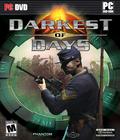The PC crowd is probably the hardest to please when it comes to an FPS title because they've seen nearly everything. It's the platform on which the genre had its start and where it continues to thrive despite the rise of the console generation. That kind of history also tends to raise the bar on anything new hitting the shelves on console or PC. Phantom EFX, best known for its Reel Deal series of casino games, is a genre newcomer and has some difficulty hitting this bar.
They founded 8MonkeyLabs to develop Darkest of Days, their first attempt at the genre. The premise sounds like a blend between "Back to the Future," "Timecop," Star Trek-inspired sci-fi, and maybe even a little Daikatana. With a new engine, promising setting, and the urge to use advanced weapons against woefully unprepared soldiers from the past, it sounded like it couldn't go wrong, but it does.
The history-heavy, sci-fi story line drops players into the boots of Alexander Morris, a soldier in the service of General Custer at his infamous "Last Stand" at the Little Bighorn on June 25, 1876. It wouldn't be much of a game if you actually died along with everyone else, though, so at the moment of death, a helmeted time traveler steps out of a portal, and off you go to the future to join up with KronoteK, who recruit you to help in researching history and defend against any strangeness that may occur.
Darkest of Days' take on time travel won't leave you scratching your head, but you also don't have to be a quantum physicist to see that there are a few plot holes. For one thing, they state that they haven't developed a way to travel forward in time, only backward, although it is curious that they are able to return to their point of origin if forward travel isn't possible. Don't even get me started on the butterfly effect. It does provide a fantastic excuse to turn history into one huge battlefield. Soldiers armed with muskets versus an assault rifle with automatic aiming? Yes, please.
You'll also have to believe that a training session that can last only a few minutes to teach a 19th century soldier to be proficient in everything from pistols to high-tech weapons of mass destruction. Regenerating health is also in, and it can often feel as if it takes forever to get back into the action (although reloading save games is lightning-fast). There's even a hub system that allows you a little freedom in selecting which mission you want to take on first.
The checkpoint system manages to keep you from repeating too much, but it's not perfect and can save your position even though you're surrounded on all sides. The FPS mechanics are also bare-bones basic, lacking a lean or cover system of any kind, which may be a major turn-off for players.
Weapon-wise, it lives up to most of its billing, with period pieces that range from one-shot musket rifles to an impressively futuristic überweapon that brought back a few microwave memories from Crusader: No Regret. There's also a sniper rifle that feels as every bit as advanced as it should be; the assistance reticle calculates every possible environmental factor and turns a simple shot into a high-tech mini-game.
Each weapon also has its own unique reload animation, especially the muzzle-loaded rifles, and a reload bar shows how long it will take to get ready. If the player manages to hit the reload button again at the right moment, similar to Gears of War, the time it can take to load a weapon is shortened, which comes in incredibly handy when you don't have something better on hand to replace the musket. You don't get to pick out your weapons before a mission, even though you often have the choice of which mission you want to undertake first.
Even worse, the oddly disjointed logic of the game that may load you up with future weapons in one mission and none in the next also means that anything you find can't be carried along. This can be incredibly annoying when the weapons are from the same period, as the repeater rifle you had picked up earlier is replaced with another musket instead.
The actor behind Morris' in-game buddy, Agent Dexter, does an admirable job as a hard-drinking, no-nonsense mentor, but the rest of the acting throughout the game isn't as good — especially when a lot of it sounds as if people are speaking directly into a microphone instead of yelling at you from the top of a hill 100 yards away. The rest of the sounds in the game aren't that great, either, with Morris' footsteps over dried leaves and gravel sounding as quiet as a whisper. Walking through bushes, tall grass and tree branches also takes me back to the days of silent 2-D foliage. Hitting someone with a melee attack sounds as if you were punching a marshmallow.
During the big battles, however, the feel of the game dramatically changes. Hearing the report from dozens of Confederate and Union rifles as they face off against each other, the rumble of Mt. Vesuvius in the distance as a fountain of molten rock gushes, and seeing massive numbers of troops rush each other across a killing field create atmospheric scenes of fantastic chaos as if you were on the front lines of a Total War game — but only on the surface.
KronoteK wants you to save people who shouldn't have been at these events, and thanks to some unexplained technology, these important individuals are indicated with an orange aura. To make things even more interesting, there are also other people in these battles who play minor roles in the history books and are indicated with blue auras.
Shooting these people in the legs, the shoulder, or using a fancy little gift from the future to zap them unconscious will safely take them out of the action, adding an interesting twist to the usual shoot-'em-all formula. The only problem with this is that if other soldiers kill these guys instead, they won't suffer the same consequences. Even if you walk up to one who you'd just knee-capped, he'll eventually die anyway, but without repercussions. Occasionally, I'd simply let my allies move ahead of me and deal with these guys.
So what happens if you intentionally kill one of these "special" people? That sends up a flag for the Opposition, the generically named bad guys in the game, to find and send agents to deal with you. Since you start almost every mission with period weapons, like pistols and rifles, these future warriors are almost invincible, making them extremely dangerous opponents.
Being careful about who you shoot also allows you to accrue improvement points that can be spent in modifying the two classes of weapons: rifles and pistols. Improvements can expand the reloading "sweet spot" so that it's easier to hit, magazine size and even accuracy, although most weapons are accurate enough without upgrades. With the exception of the reload mod, most of these, didn't feel particularly useful, so it feels as if I could play the game without making any improvements at all and still win.
The engine backing Darkest of Days is certainly capable of staging large battles, but the vast, open areas are deceptively linear. Invisible walls are everywhere. Imagine playing a game like S.T.A.L.K.E.R., wanting to climb up a hill to get the drop on some enemy soldiers, and finding that you can't because of one of these unseen obstacles, even though there's open air in front of you. Imagine wanting to enter a building, only to find that the open doorway isn't really open at all, even if your eyes tell you differently. While there are a large number of open fields and spaces, don't be too surprised if you can't wander too far off the beaten path even if it looks like you should be able to.
The scripting that the game uses to tell its story is also as heavy-handed. In-game cut scenes can't be skipped, and it's often so obvious that it doesn't feel so much that you're participating in the game as you are basically told when you can. In one instance when Morris has to line up for battle, the game yanks control out of your hands to make you part of an attacking group, marching you forward like a robot. Other titles are a lot more subtle than this.
Then there's the AI. I'd sometimes find the enemy just standing around waiting for something to happen even though I was right there. In one mission, when the enemy had retreated, I decided to ignore my mission objective by following them instead and was incredibly surprised to catch up with them.
Why? They had just stopped for no apparent reason other than they were apparently "done" playing their part. None of them even lifted a rifle to my head although I had rifle-butted a few of them. They just stood where they were, reminding me of the sci-fi flick, "Westworld," when all of the robots just stopped working.
In another battle, I watched as soldiers would pop in, one right after another, as if they were rolling off of an invisible conveyor belt. I wished the game kept some kind of statistical measure of my handiwork, since I'm sure I had probably wiped out several armies by leaving the machine gun pointed at that spot. By rushing an objective point on another map, all of the enemies around me simply "disappeared" or stopped fighting and ran away.
Darkest of Days' visuals are also a mixed bag, with the weapons appearing to be the best rendered pieces of the entire production. The death animations, on the other hand, are just terrible. Everyone falls over in a handful of scripted ways, no matter where you shoot them. Hit someone in the leg, and he might clutch his stomach instead. Shoot someone in the arm, and don't be surprised to see him do the same thing again.
There's not a lot of reason to go back into the game once it's completed. There's no multiplayer, no extras are unlocked, and no cheat modes are available from the menu. There's nothing at all to reward the player other than the promise of a sequel. The PC packaging doesn't come with a warranty postcard or a hard copy of the manual, probably to help cut costs. If you need the instructions, you'll have to explore the DVD and open up the PDF file.
Darkest of Days isn't a complete disaster — after all, I've played You Are Empty — but as much as I wanted to like it, it would probably need its own "Groundhog Day" to help fix what's wrong. The premise is great, the big set-piece battles are fun, but everything else is boxed within dated design concepts from which other titles have long evolved. The nice thing about evolution is that, in theory, the next iteration might be better.
Score: 5.0/10
More articles about Darkest of Days











 In Darkest of Days, the action begins with the player being ripped from his period in time by a mysterious organization moments before his grisly death. In order to ensure the future of mankind, he is then tasked with the mission to travel back and forth through time to famous, turning-point battle campaigns in world history acting as the organizations agent in a larger, seemingly otherworldly, battle between good and evil.
In Darkest of Days, the action begins with the player being ripped from his period in time by a mysterious organization moments before his grisly death. In order to ensure the future of mankind, he is then tasked with the mission to travel back and forth through time to famous, turning-point battle campaigns in world history acting as the organizations agent in a larger, seemingly otherworldly, battle between good and evil.


















































